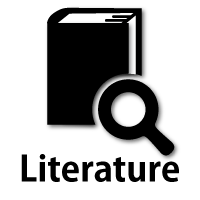For those interested in muscle diseases
Two main groups of muscle diseases
Muscle diseases are categorized as conditions caused by impairment of the nervous system that controls the muscle fibers and conditions secondary to impairment of muscle fibers themselves. The former is referred to as neurogenic muscle atrophy and the latter as myopathy.
1.Neurogenic muscle atrophy
Neurogenic muscle atrophy is categorized into two groups as follows: (A) Disorders caused by impairment of secondary motor neurons located in the spinal cord. This disorder is called motor neuron disease. A neuron is a nerve cell that serves as the basic structural and functional unit of the nervous system. Neurons form intricate networks for the transmission of electrical and chemical signals for effective neural communication. Primary motor neurons are in the brain, and their major branches (axons) are connected to secondary motor neurons. Primary motor neurons transmit signals to secondary motor neurons, which transmit motor commands for muscle movements. This command is further transmitted to the muscle fiber via peripheral nerves, which carry signals from the spinal cord to muscle fibers. (B) Neuropathy, which refers to disorders caused by impairment of peripheral nerves.
Amyotrophic lateral sclerosis is the most common motor neuron disease, which involves both primary and secondary motor neurons. Several types of neuropathies contribute to muscle atrophy. It is important to clinically distinguish between motor neuron diseases and neuropathies. In addition to a thorough neurological examination, electrophysiological tests are important diagnostic tools.
2.Myopathies
Several myopathies are attributable to genetic abnormalities. Genes are codes written in an individual’s DNA and direct the formation of proteins, which constitute the building blocks of the human body. Therefore, genetic abnormalities lead to the production of abnormal proteins. Genetic abnormalities can be transmitted from parents to offspring or can occur incidentally during the process of reproduction. Such disorders are called hereditary myopathies. Muscular dystrophies and congenital myopathies constitute the major hereditary myopathies. Muscular dystrophies are essentially progressive in nature, whereas congenital myopathies are non-progressive or only mildly progressive. However, these hereditary myopathies are often indistinguishable.
Non-hereditary myopathies are a class of myopathies that occur secondary to non-genetic factors including infection, cancer, abnormalities in the immune or endocrine system, and due to toxic substances.
(1) Muscular dystrophies
Muscular dystrophy is the name given to a group of inherited muscle disorders. The nomenclature used to describe these disorders is based on the manner of inheritance, name of the individual who first described the condition, names of muscles that are first affected, names of gene mutations, and primary symptoms, among other such factors. Understandably, the nomenclature and classification appear complicated.
The main types of muscular dystrophy include the following:
- X-linked recessive muscular dystrophy (Duchenne muscular dystrophy and Becker muscular dystrophy)
- Congenital muscular dystrophy
- Limb-girdle muscular dystrophy
- Facioscapulohumeral muscular dystrophy
- Myotonic dystrophy
- Other rare forms of muscular dystrophy (oculopharyngeal muscular dystrophy, Emery-Dreifuss muscular dystrophy, and distal muscular dystrophy, among others.)
a. X-linked recessive muscular dystrophy (Duchenne and Becker muscular dystrophies)
The gene that undergoes the mutation associated with Duchenne and Becker muscular dystrophies is located on the short arm of the X chromosome. Both dystrophies are inherited as an X-linked recessive trait; therefore, as noted with other X-linked recessive diseases, they primarily affect males (boys and young males). Males have one X chromosome and females have two. Females who carry one mutated X chromosome are carriers and may manifest with mild symptoms depending on the role of the mutated X chromosome in formation of muscle fibers. Duchenne muscular dystrophy occurs in approximately 1 in 4,000 male live births. Notably, one third are sporadic cases (occurring secondary to a de novo mutation). A de novo mutation is a new germline mutation that is not inherited from either parent and is present for the first time in one family member.
Symptoms of Duchenne muscular dystrophy are commonly noticed in children aged 2 to 5 years, who show unsteadiness when trying to stand and walk. Muscle weakness becomes progressively more noticeable as the child runs slower than peers, falls frequently, and shows difficulty jumping. Owing to weakness of the muscles around the hip girdle, the child finds it difficult to rise from the floor and pushes his knees with his hands (commonly referred to as walking his hands up his legs) to brace himself as he rises to a standing position (Gowers’ sign), which is classically observed in patients with proximal muscle weakness, primarily of the lower limbs. The child typically needs to raise his hip on the side on which he raises the leg when walking, resulting in a waddling gait. Muscle wasting and weakness of thigh muscles and relatively well-preserved and often disproportionately large calf muscles characterize this condition. The calf muscles feel hard to the touch compared with other muscles. This sign is called pseudohypertrophy of the calves. Wasting and weakness of the muscles around the shoulders with atrophy of the scapular muscles (muscles of the shoulder blades) result in a wing-like appearance (the scapula appears elevated from the back). With further progression of the disease, major joints, particularly the ankles show limitation in range of movement leading to unsteadiness of gait with difficulty in standing on the heels owing to shortening of the Achilles tendon.
Patients show severe functional impairment in their late teens as progressive weakness significantly limits walking ability. They also develop respiratory and various degrees of cardiac dysfunction. A small percentage of patients may show developmental abnormalities of the brain.
Becker and Duchenne muscular dystrophies are both caused by mutations in the gene encoding dystrophin. However, owing to different mutations in the same gene, symptoms of the Becker type are milder than Duchenne type dystrophy. The distribution of the affected muscles and other signs and symptoms are similar in nature, although disease onset is variable and usually occurs later than in patients affected by the Duchenne type of disease. Becker muscular dystrophy commonly occurs in the late teens, shows slower progression and is associated with a lower risk of cardiac involvement.
b. Congenital muscular dystrophies
Patients with congenital muscular dystrophies often show significant delay in achieving developmental motor milestones and are unable to walk independently. However, many cases in the literature describe patients with mild symptoms, and the classical clinical presentation is no longer observed. Therefore, the distinction between congenital muscular dystrophies and other dystrophies is becoming increasingly blurred. For example, Fukuyama congenital muscular dystrophy (FCMD), the most prevalent form in Japan, now includes patients with milder symptoms who can walk, thanks to an establishment of genetic diagnosis. Most patients with FCMD show muscle weakness and joint contractures in addition to neurodevelopmental impairment resulting in mental retardation and epilepsy.
A study from UK has reported that the commonest form of congenital muscular dystrophy in Europe is merosin-deficient congenital muscular dystrophy type 1A (MDC1A) (37%) followed by dystroglycanopathies (27%). FCMD belongs to the latter category. In Europe however, muscle eye brain disease and related conditions are prevalent among the dystroglycanopathies.
c. Limb-girdle muscular dystrophies
Limb-girdle muscular dystrophies (LGMD) refer to a group of myopathies that cause gradually progressive muscle atrophy in the proximal groups of muscles (muscles near the center of the body), with onset in adolescence to early adulthood. Most patients show an autosomal recessive inheritance pattern, although cases showing autosomal dominant inheritance have been reported. Owing to a series of genetic discoveries and a better understanding of the genetic basis for various subtypes, LGMD is recognized as a broad group that includes patients presenting with a wide spectrum of neuromuscular disorders that cannot be classically categorized based on the aforementioned definition, such as those with a very early or extremely late disease onset and those with unusual patterns of distribution of weakness. To date, more than 40 conditions are classified as LGMD. These are limited to those in which genetic mutations were identified. Calpainopathy (LGMD2A) followed by dysferlinopathy (LGMD2B) are the most common subtypes.
d. Facioscapulohumeral muscular dystrophy
This condition is characterized by involvement of facial muscles, as well as those around the scapula and the upper arms. Disease onset commonly occurs during childhood with gradual progression until the leg muscles are affected in the later stages. The condition shows an autosomal dominant inheritance pattern (transmission from parent to offspring).
e. Myotonic dystrophy
Myotonia is a medical term that describes continued (prolonged) involuntary muscle contraction with delayed relaxation following voluntary contraction. Patients usually show difficulty opening the hand immediately after making a tight fist. Myotonic dystrophy presents with muscle weakness in association with myotonia and causes multisystem involvement presenting with diabetes mellitus, cataract, baldness, arrhythmia, and/or gallstones. Involvement of facial muscles often causes drooping of the eyelids. The disorder shows an autosomal dominant inheritance pattern, and patients tend to show an earlier disease onset than their parents.
f. Other muscular dystrophies
Relatively uncommon muscular dystrophies include oculopharyngeal muscular dystrophy, which involves muscles around the eyes and the throat and Emery-Dreifuss syndrome that causes contractures of the elbow and neck, as well as cardiac arrhythmia.
(2) Congenital myopathies
Advances in diagnostic techniques, such as immunohistochemistry and electron microscopy have led to the discovery of congenital myopathies, which are identified by these novel techniques based on their characteristics. Congenital myopathies include nemaline myopathy, myofibrillar myopathies, central core disease, and many other diseases.
Congenital myopathies are usually defined as early-onset myopathies showing mild or no progression. However, late-onset disease may occur in middle age or later and evidence of progression comparable to muscular dystrophies may be observed in a few cases.
(3) Inflammatory myopathies (myositis)
Myopathies associated with inflammation are referred to as inflammatory myopathies or myositides. Inflammation is a tissue response triggered by infection, tissue injury, allergy, and other immunemediated mechanisms. Myositis can be caused by various infectious agents including viruses, bacteria, and fungi, among others. Non-infectious myositis includes a variety of collagen vascular diseases, such as dermatomyositis and polymyositis. Myositis is also known to occur in association with other collagen diseases, including mixed connective tissue disease, scleroderma, systemic lupus erythematosus, rheumatoid arthritis, and Sjogren syndrome. Cancer-associated myositis is reported in the available literature. Myositis is known to occur in patients with human immunodeficiency virus, human T-cell lymphoma virus type I, and hepatitis B and C virus infections. Furthermore, several non-infectious inflammatory myopathies have also been reported, although causes of these conditions remain unclear.
a. Polymyositis
Polymyositis should be considered in adults presenting with myopathies but without a family history of myopathy. Polymyositis may include numbers of conditions described recently as immune mediated necrotizing myopathies or paraneoplastic myositis. It can show a variable course ranging from acute to chronic. Typically, it affects the proximal muscles with consequent difficulty standing from a sitting position or raising one’s arms. Some patients may develop systemic symptoms including fever, as well as muscle and/or or joint pain. Blood tests usually reveal elevated serum protein levels indicating leakage of muscle proteins (example creatine kinase) from the injured muscle cells. Serum creatine kinase levels may exceed 10,000 IU/L (usual levels <200 IU/L). Patients with an acute severe presentation may show dark reddish colored urine containing myoglobulin in addition to respiratory complications and/or dysphagia.
b. Dermatomyositis
Dermatomyositis and polymyositis share clinical and histopathological features with regard to muscle symptoms, although dermatomyositis is associated with characteristic cutaneous manifestations. However, reportedly, these disorders differ regarding their etiopathogenetic mechanism. The hallmark cutaneous manifestations of dermatomyositis include violaceous reddish discoloration of the upper eyelid, which may occasionally be accompanied by edema and dilated blood vessels (heliotrope rash), thick scaly skin with reddish discoloration on the back of the joints including the finger joints, elbows, or the knees (Gottron’s sign) and further darkening with disease progression (poikilodermatous erythema), erythema on the shoulders and back (shawl sign), as well as erythema over the anterior neck and center of the chest (V-neck sign). These peculiar patterns of skin rashes provide important diagnostic clues. Dermatomyositis is often complicated by interstitial pneumonitis and is often associated with malignant neoplasms.
c. Inclusion body myositis
Many inflammatory myopathies are resistant to immunotherapy, such as corticosteroid therapy in elderly patients. Inclusion body myositis characterized by inclusion bodies in the muscle tissue is an example of such an inflammatory myopathy. The inclusion bodies comprise filamentous structures in and around the vacuoles formed within muscle fibers.
(4) Metabolic myopathies
a. Myopathies caused by congenital metabolic disorders
Glycogen storage diseases are caused by defects in enzymes participating in glycogen metabolism. These include type II or alpha-glucosidase deficiency (Pompe disease), type III or debranching enzyme deficiency, type V or myophosphorylase deficiency (McArdle disease), type VII or phosphofructokinase deficiency (Tarui disease), and type VIII or phosphorylase kinase subunit deficiency. Type II mimics symptoms of muscular dystrophy, such as dysphagia and respiratory failure, in both infantile and adult forms. Types V and VII are associated with muscle pain, fatigue, and weakness following exercise. However, type V is often associated with the ‘second wind phenomenon’, which is rare in cases of type VII disease. The ‘second wind phenomenon’ refers to symptom amelioration with continued exercise despite initial fatigue and weakness. Type VII disease is associated with hemolytic anemia.
Myopathies caused by abnormalities of lipid metabolism are relatively uncommon, although patients may present with a wide variety of symptoms and severity. Some of these disorders are associated with impaired cardiac function.
b. Mitochondrial cytopathy
Mitochondria are organelles (small organs within cells) that are essentially the energy production units in cells and contain their own small DNA. Mitochondria are inherited from the mother along with DNA via the ovum. Sperms do not contain mitochondria; therefore, mitochondrial DNA is maternally inherited. Mitochondrial cytopathies comprise diseases caused by abnormalities in mitochondrial DNA or in nuclear DNA that is involved in mitochondrial metabolism.
Owing to the ubiquitous distribution of mitochondria, symptoms of mitochondrial cytopathies vary significantly. Typical conditions include disturbances in eye movements (progressive external ophthalmoplegia), various myopathies, epilepsy, stroke-like episodes, ataxia, and combinations of these conditions. Combinations of these symptoms are seen in Kearns-Sayre syndrome, mitochondrial myopathy, encephalopathy, lactic acidosis and stroke-like episode (MELAS), myoclonic epilepsy with ragged-red fibers (MERRF) and several other syndromes.
Muscle biopsy, as well as genetic studies on mitochondrial DNA and nuclear DNA may be helpful for the diagnosis of mitochondrial cytopathy.
c. Periodic paralysis
Periodic paralysis is characterized by episodes of sudden weakness without other accompanying symptoms in a seemingly healthy individual. It may be induced by hypokalemia in addition to several other causes. Hyperthyroidism is a known etiological contributor in Asians. Several types of hereditary periodic paralysis are recognized, including those primarily associated with mutations in genes coding ion channel receptor proteins. Such genetic mutations may contribute to hyperkalemic, as well as hypokalemic periodic paralysis.
(5) Endocrine myopathy
a. Myopathies associated with thyroid diseases
Hyperthyroidism is often associated with myopathy in addition to periodic paralysis. Hypothyroidism can also cause myopathy. Furthermore, chronic thyroiditis occasionally presents with a combination of myositis and myasthenia gravis.
b. Muscle atrophy associated with diabetes mellitus
Diabetes mellitus is often associated with a variety of neurological complications. Muscle atrophy observed in patients with diabetes is primarily attributable to diabetic neuropathy.
c. Myopathy associated with other endocrine diseases
Cushing disease and Cushing syndrome are characterized by hypersecretion of corticosteroids from the adrenal glands and cause muscle atrophy and weakness. Similar symptoms are observed in patients treated with corticosteroids for a wide variety of diseases.




